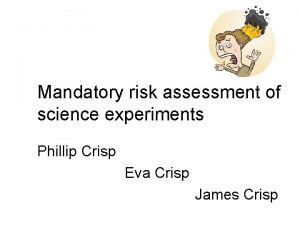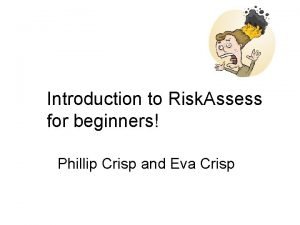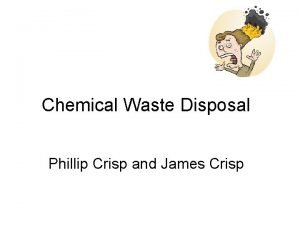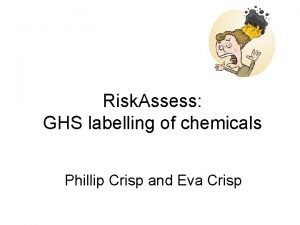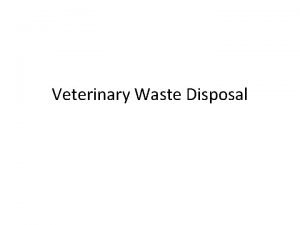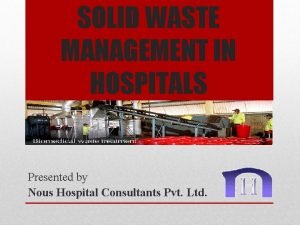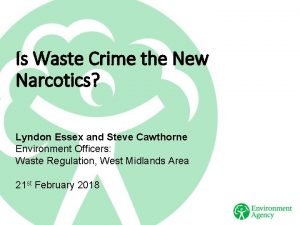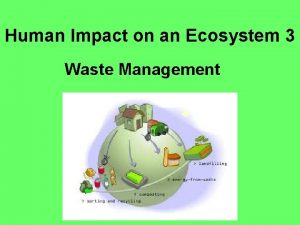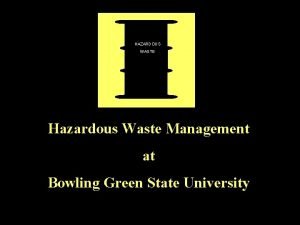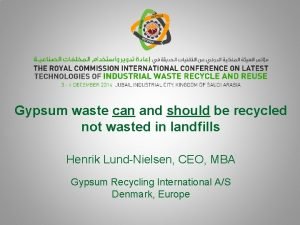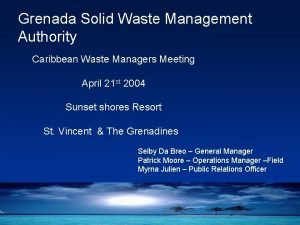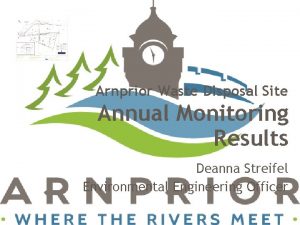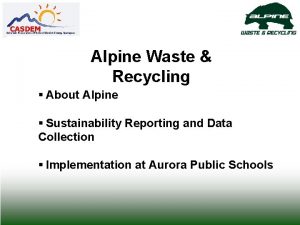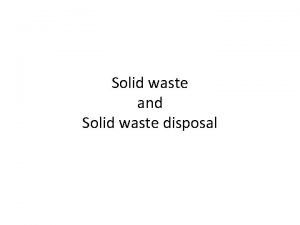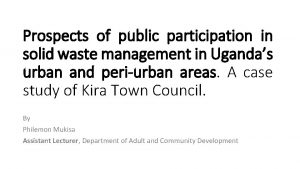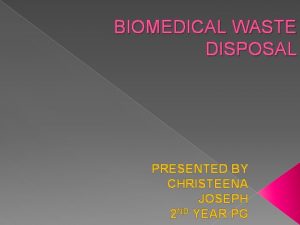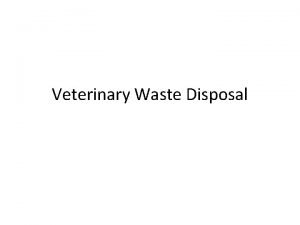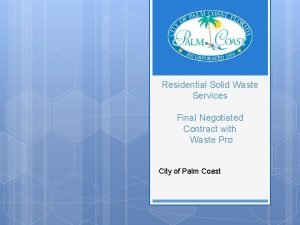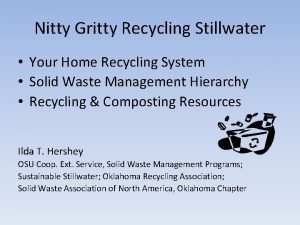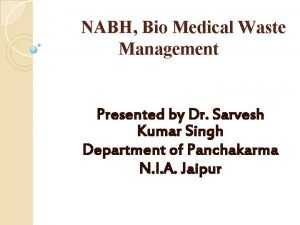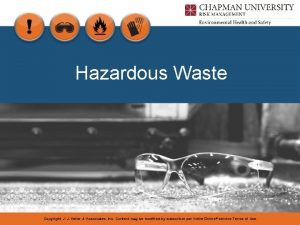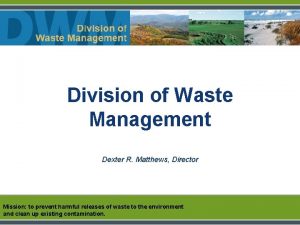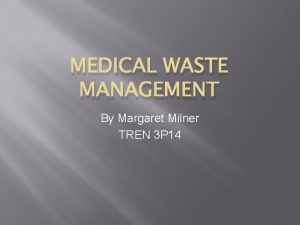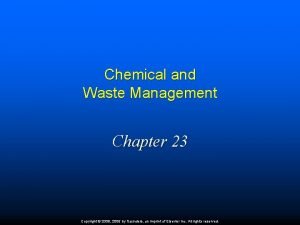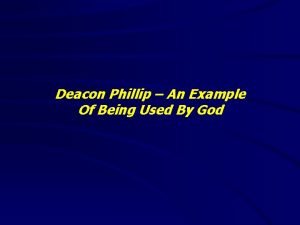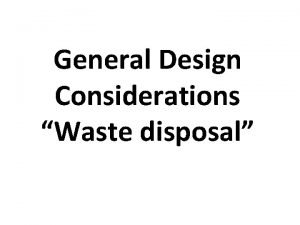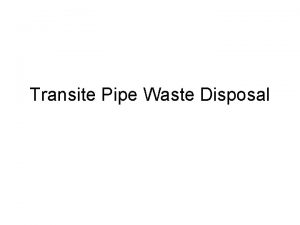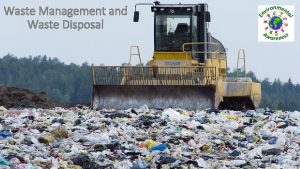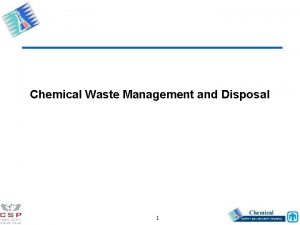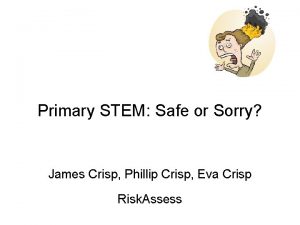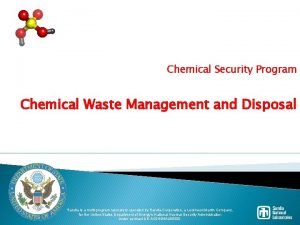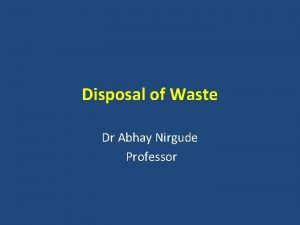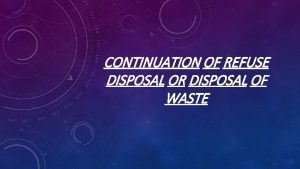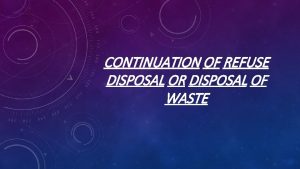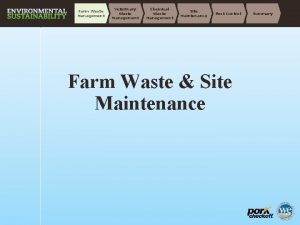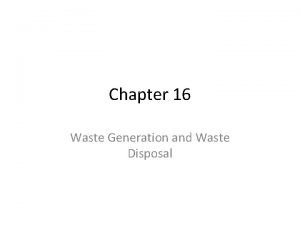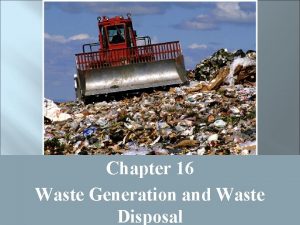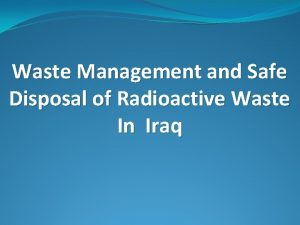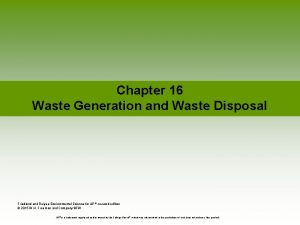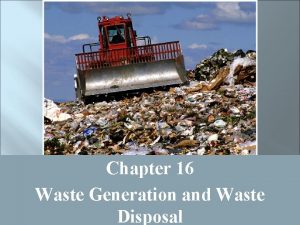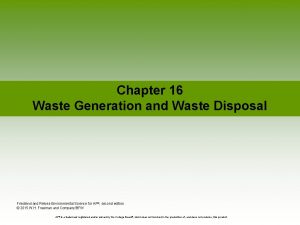Chemical Waste Disposal Phillip Crisp and James Crisp































- Slides: 31

Chemical Waste Disposal Phillip Crisp and James Crisp

Chemical Disposal The quantity of chemical wastes generated in a school is insignificant. HOWEVER • A school is an educational institution • Attitudes adopted during youth continue into adulthood • Proper training should be given to those who will later be decision makers

The improvement process • eliminate unwanted chemicals • redesign procedures to minimize waste production, e. g. spot reactions, recycling, destruction, less toxic chemicals • dispose of wastes LEGALLY SAFELY by - sewer - garbage - waste collection service

THE LAW Follow all * WA laws * local government/authority regulations instead of the advice in Risk. Assess whenever there is conflict between the two

Water Corporation Laboratory chemical waste https: //www. watercorporation. com. au/Help-and-advice/Trade-waste-inyour-business/Other-industries/Laboratory-chemical-waste • chemicals of major concern • waste avoidance and minimisation • best management practices & specific requirements Laboratory waste from schools http: //www. labnetwest. asn. au/wp-content/uploads/2020/06/Laboratory-waste-fromschools. pdf Acceptance criteria for trade waste https: //www. watercorporation. com. au/Help-and-advice/Trade-waste/Permits-andcharges/Trade-waste-permits/Acceptance-criteria-for-trade-waste • substances subject to acceptance criteria • acceptance criteria for common waste components • acceptance criteria for large metropolitan WWTPs

Waste Authority • Waste Wise Schools program https: //www. wasteauthority. wa. gov. au/wws • Household Hazardous Waste free dropoff https: //www. wasteauthority. wa. gov. au/programs/view/household-hazardous-waste • school laboratory garbage?

Chemical wastes in schools * Aqueous liquid wastes • dissolved salts • acidic or basic • suspended particles Water-miscible organic wastes • alcohols, e. g. methylated spirits • ketones, e. g. acetone Water-immiscible organic wastes • hydrocarbons, e. g. hexane, kerosene • special chemicals, mostly for organic chemistry Solid wastes • precipitates, e. g. Ba. SO 4, Fe oxides

Problems in the sewer! • toxic metals e. g. Hg, Cd, Pb, As, . . . VERY BAD Cu, Ni, Co, . . . BAD since contaminate sludge $$$ • toxic persistent organic chemicals e. g. pesticides since contaminate sludge $$$ • highly acidic/alkaline liquids since may damage pipes • flammable liquids (water-immiscible) since may cause an explosion!

Aqueous liquid wastes Pour down the sewer ONLY if the criteria of the water authority are met. Otherwise, an environmentally responsible approach: • neutralize to ~p. H 6. 5 -8. 5 (natural waters) • only “safe” amount of each chemical down the drain in order to minimise environmental harm from treated sewage when it is released into river or ocean. All wastes exceeding a “safe” amount of a chemical should be retained for a waste collection service. WHAT IS SAFE?

Estimation of “safe” quantities* Consider the cation and anion in a salt separately. Toxicity of a salt is dominated by the most toxic ion: e. g. lead chloride, potassium dichromate Some ions should not go down the drain at all e. g. Hg 2+, Pb 2+, Cd 2+, . . . while others are ok almost without (school) limit e. g. Na+, Ca 2+, Cl-, SO 42 -, . . . and other ions in between * Risk. Assess “Disposal of chemical wastes”, in Learning Resources

Tabulation and calculation “Safe” disposal quantity for an ion for a class: 0 – 1000 g/day Copper sulfate copper: 1 g/day [Very toxic to aquatic life with long lasting effects] sulfate: 1000 g/day. [In solid laundry detergent] Therefore, copper sulfate: 1 g/day (as solid or solution) Enough for some spot tests down the drain. Beyond that, wastes need to be collected!

Comparison (g/day) to sewer Element Water Corporation* Arsenic 1 Cadmium 1 Chromium 30 Copper 30 Lead 30 Mercury 0. 1 Molybdenum 1 Nickel 6 Selenium 1 Silver 2 Zinc 50 Risk. Assess 0 0 10 1 0 0 1 1 10 * Acceptance criteria for large metropolitan WWTPs

Organic liquid wastes Water-miscible e. g. methylated spirits, acetone Dilute 1 part to 20 parts water, then down the drain. Prevents explosive air/vapour mixture. Microorganisms in sewer will consume the chemicals. Water-immiscible e. g. hexane, kerosene Retain for collection by waste service. Separate hydrocarbon waste from halogenated waste.

Aqueous waste containers Cations Large bottles half-filled with 110 g/L Na 2 CO 3 e. g. Cd, Co, Cu, Pb, Hg, Ni, Zn ions Large bottle half-filled with 180 g/L Na. Cl e. g. silver ions Anions Large bottle half-filled with 150 g/L Fe. SO 4 e. g. chromate ions Large bottle half-filled with 350 g/L Ca. Cl 2 e. g. fluoride ions SEPARATE CONTAINER FOR EACH ION !

Solid wastes Only “material of a domestic nature” is allowed to be disposed of in the garbage Consider • transport of garbage • leaching from landfill Geologically-stable minerals (precipitated during reactions) e. g. barium sulfate (baryte) No leaching of toxic chemicals in a domestic landfill.

Labelling and storage of wastes All wastes must be • labelled according to GHS, and • stored according to Dangerous Goods Class. Especially: Flammable wastes in a flammable liquids cabinet! Place each toxic waste in a SEPARATE container! Most easily, use Risk. Assess labels: • standard labels for single-component wastes • custom labels for multicomponent wastes


Purpose of disposal advice • focuses on avoiding serious environmental harm • reduces the cost of waste collection service • decreases emphasis on less harmful substances • provides a learning tool for staff and students • promotes care for the environment

Current disposal advice Free Learning resources: • ‘Disposal of Chemical Wastes’ document • this presentation (for teaching others) Within Risk. Assess: • ‘Safety in Schools’ book, chapter C 7: ‘How to dispose of chemical wastes’

Future disposal advice: advice for each individual chemical • advice for each of the 3000 chemicals/solutions • following logic of ‘Disposal of Chemical Wastes’ • under ‘Standard handling procedures’ • no need to calculate for each chemical/solution • dedicated waste container information • simplify disposal and save money • completion early 2021 (Big job!)

CHEMICAL SPILLS • Deal with injured persons • Prevent further injuries • Seek assistance e. g. Emergency 000. . . . • Contain the spill • Clean up the spill • Render spilled material harmless

Procedures for chemical spills • Acids • Alkalis • Organic solvents • Mercury • Solids

Spills kit Rubber gloves Safety goggles Mop and bucket Dust pan and brush Four 5 L plastic buckets Plastic shovel NOTE: Keep in front of chemical store! 10 kg kitty litter (dried bentonite clay NOT paper) 2 kg sodium bicarbonate 2 kg calcium hydroxide (10 kg dry sand) (2 kg sulfur for mercury decontamination) Paper towels


What is Risk. Assess? • web-based risk assessment tool • customised to the school situation • provides - electronic templates (AU/ISO) - database information on risks (chemical, equipment, biological) - equipment ordering/lab scheduling - labelling (GHS) - learning resources • easy sharing of experiment templates for customisation


Logic • separate sections for teacher and laboratory technician • initial assessment of inherent risk - if low, go to end - if medium or more, record control measures - if high or extreme, third reviewer required • cross-checking by teacher/labtech/reviewer • scheduling, ordering, labelling to save time • inexpensive ($250+GST per campus per year)

Electronic system • relatively rapid • prompts sensitive to context • reduces paper consumption • easy to review and update • easy monitoring and statistics • easy storage • demonstrated to work in schools Risk. Assess: 2250 schools AU+NZ+CA WA: 45 (13%) 3, 700, 000 risk assessments

Details • access from school/home • nothing to install on computer, tablet or phone (instant update) • unlimited number of simultaneous users and risk assessments • minimal data entry See brochure! • complements SDSs • continuing input from science staff • multiple backups of data & backup server • support and advice

Advantages of Risk. Assess • proper consideration of risks and control measures • standardisation • storage of records for legal purposes • communication between teachers and laboratory technicians • discourages spur-of-the-moment experiments • useful for new/inexperienced staff

Even more! • scheduling system • prac ordering • GHS labelling - standard - customised And an exciting new video. . . “Getting Started with Risk. Assess” starring Phillip and Eva!
 Science experiment risk assessment
Science experiment risk assessment Phillip crisp
Phillip crisp Phillip crisp
Phillip crisp Phillip crisp
Phillip crisp Waste service lindsay
Waste service lindsay Veterinary waste management
Veterinary waste management Waste color coding
Waste color coding Waste disposal lyndon
Waste disposal lyndon 3 waste disposal
3 waste disposal Screw feed technology of waste management
Screw feed technology of waste management Waste bowling green
Waste bowling green Disposal of gypsum waste
Disposal of gypsum waste Trash service grenada
Trash service grenada Arnprior waste disposal site
Arnprior waste disposal site Alpine waste
Alpine waste Summary of biomedical waste management
Summary of biomedical waste management Ramp method of waste disposal
Ramp method of waste disposal Solid waste disposal introduction
Solid waste disposal introduction Introduction of biomedical waste
Introduction of biomedical waste Veterinary waste disposal legislation
Veterinary waste disposal legislation Municipal solid waste management definition
Municipal solid waste management definition Palm coast waste
Palm coast waste Garbage company stillwater
Garbage company stillwater Waste disposal procedure sample
Waste disposal procedure sample Hazardous waste transportation
Hazardous waste transportation Trash services grenada
Trash services grenada Matthews waste disposal
Matthews waste disposal Milner waste disposal
Milner waste disposal Chemical and waste management chapter 23
Chemical and waste management chapter 23 Deacon and phillip
Deacon and phillip James clayton lawson
James clayton lawson James clayton lawson
James clayton lawson
